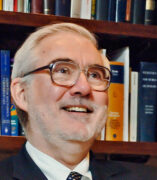
Eric Gislason
Emeritus Professor and former UIC Chancellor
Contact
Address:
5204 SES, MC 111
Office Phone:
Email:
About
I am interested in a number of theoretical projects in the area of chemical dynamics. Most of these involve chemical reactions that take place on more than one electronic potential energy surface. One of these is the three-body fragmentation of the molecular ion Na3+ following excitation by a fast He atom. The two-step process is
Na3+ + He -> (Na3+)* + He (1)
(Na3+)* -> Na+ + Na + Na . (2)
At the end of the fragmentation there are three degenerate singlet electronic states. (The positive charge can be on any of the three Na nuclei; each possibility corresponds to a different electronic state.) Early in the fragmentation process the three adiabatic electronic states are not degenerate, and the populations of the three states are not the same. As the fragmentation process evolves there is no compelling reason why the populations of the three adiabatic states should become equal as the three states reach the asymptotic region where they are equal in energy. In a recent paper (E. A. Gislason et. al., Chemical Physics Letters 341, 568 (2001)) we have shown that it is straightforward to determine the populations of the three adiabatic states at the detector. Our research team has measured these populations in a sophisticated experiment, where all three product particles produced in a single event are detected in coincidence. In addition, we have calculated these populations using a theoretical approach that follows the evolution of the fragmentation event on the three potential surfaces simultaneously. The experimental and theoretical results are summarized below. These results are the first determination of the product populations in a three-body fragmentation event. Clearly, the populations of the three states at the detector are not equal.
Reaction cross sections as a function of J for F+HD(v = 0,J) and F+h2(v = 0,J) at E=2 kcal/mol. For F+HD the FD(FH) products are denoted by open triangles (open circles). The cross sections for F+h2 have been divided by 2 and are shown as closed circles. The 68% confidence limits are shown at selected J values.
Education
BA, Oberlin University, 1962
PhD, Harvard University, 1967
Postdoctoral Fellow, University of California, Berkeley, 1967-69
Visiting Scientist, FOM Institute for Atomic and Molecular Physics, Amsterdam, 1977-78
Visiting Professor, University of Paris at Orsay, 1985